


Garfield states Perkin became a wealthy man, producing synthetic versions of mauve, magenta, pink, green, blue, fuchsine, yellow, red, violet and brown. Who chose to wear a lilac-colored velvet gown to her daughter’s wedding in 1858, Since she felt mauve matched her eyes, this became her color, and sheĭid indeed influence the rest of the world desire for it. Emperor Napoleon III asked his wife Eugenie to promote the French trade by wearing garments made in Paris and Lyon. He states that the English and Scottish calico printers never paid attention untilįrance did.

Reader that Perkin chose to name his color mauveine, after the French name for the non-fast color made by natural dyes, as French designers were admired for their fashion sense and Perkin finally realized the best way to induce the fashion industry and textile companies to order mauveĭyestuff was to sell the public on desiring this “lilac” color. Scientist-inventors simply were not industrialists in those days. His fellow chemists routinely admonished him for trying to do both, as At age 18, Perkin patented mauve and went began manufacturing shortly He invented a use for coal tar by discovering the chemical make-up necessaryįor producing a fast dye on wool and silk and named it mauve. Prior to Perkin, seldom did an individualĮngage in both worlds. That of business, emphasizing manufacturing. Garfield continues in this vein and gives credit to Perkin for bridging the wide gap between the So, no one gave thought to the usefulness of these findings at No one gave any thought to the usefulness of these findings back then, and the liquid aniline was expensive and notĮasy to obtain. (Lime was used in the indigo China Blue dye process). Interestingly, he got a blue color after mixing it with chloride of lime. Some years later, Friedlieb Runge distilledĪniline from coal tar. Obtained from distilling natural vegetable indigo. In 1826, Prussian chemist Otto Unverdorben discovered aniline liquid, which he Coal tar had been found useful for waterproofing cloth, protecting timber, making rubber, and as a disinfectant for sewage. The author discusses the historical development of coal-tar products. Based on my knowledge, the original synthetic mauve dye was discovered with silk. It is not always clear if he is referring to the new dye or any of the many dyes he mentions working The fact that Garfield seldom mentions the type of fabric dyed: cotton, silk, Given by Garfield relate to wool and silk, rather than cotton textiles. I have the impression that many of the dyes, colors, and information Leading up to the development of synthetic dyes for textiles, rather than a history ofĭyeing. History and development of the industrial chemical industry in general and coal-tar products in particular. Mauve reads like a novel, telling about the


 0 kommentar(er)
0 kommentar(er)
